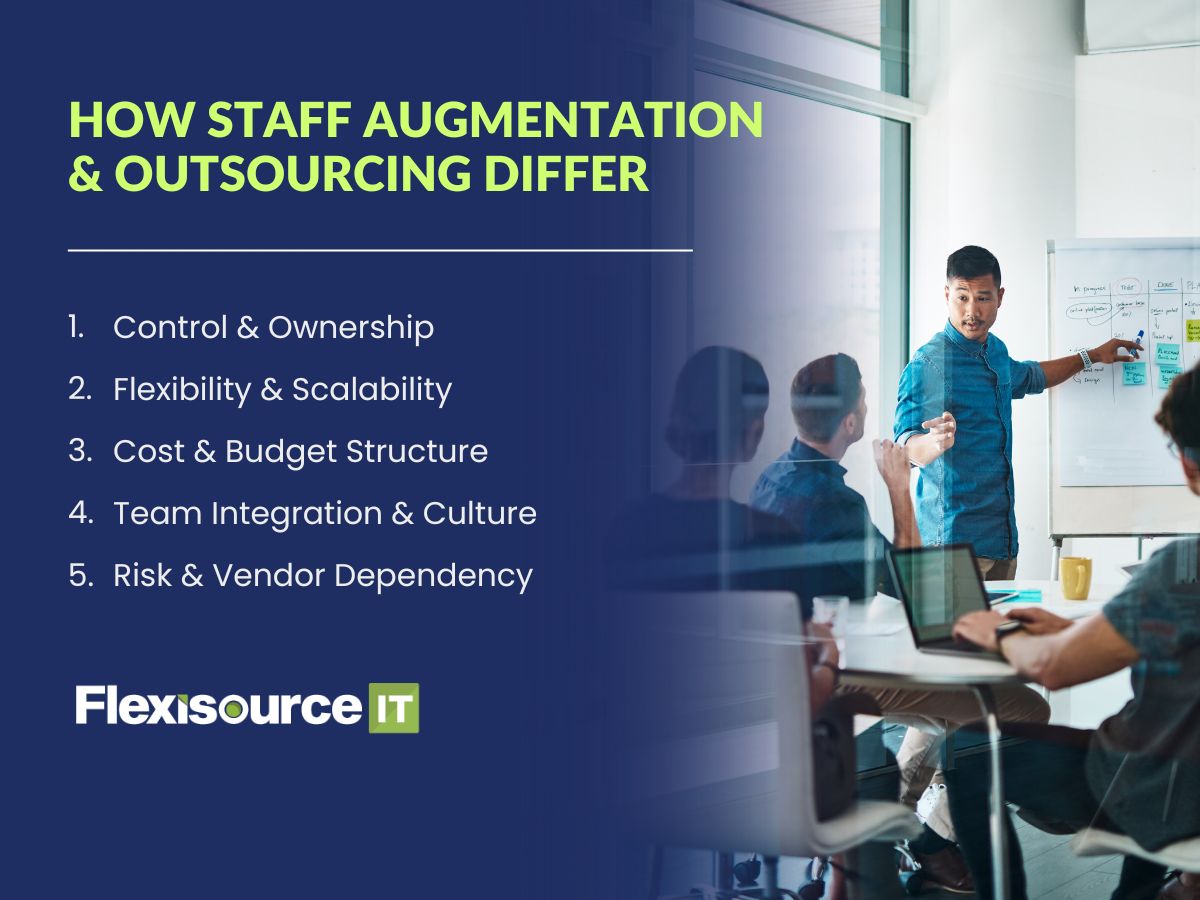Choosing how to bring extra tech capability on board can change how quickly and cleanly your project delivers. This article teases apart two common approaches so you can see what suits your situation. Read on to find a clear comparison that helps you decide with confidence.
What Is IT Staff Augmentation?
IT staff augmentation means bringing in temporary IT professionals like developers, engineers, testers and cloud specialists to support your team. They work under your guidance and use the same tools and processes you already rely on. This model helps you maintain control while quickly filling skill gaps with specialised expertise.
These IT experts stay with your team for the duration of the project and step out once the work is complete. Their contribution helps you deliver on deadlines and meet technical requirements without long hiring processes. Many Australian businesses use IT staff augmentation for agile projects, quick feature rollouts and short term product pushes.
What Is Traditional Outsourcing?
Traditional outsourcing means contracting a vendor to deliver a project or run a function end to end. The vendor supplies staff, management and processes and is accountable for agreed outcomes. This model suits organisations that prefer to focus internal resources on strategy rather than day to day delivery.
Outsourcing often comes with a fixed scope and pricing structure that is easier to budget for. The vendor operates with its own practices which can speed delivery if the scope is stable. Australian businesses commonly use outsourcing for large implementations or ongoing services like infrastructure or managed support.
How Staff Augmentation & Outsourcing Differ
The right talent model can make or break your project’s success. Understanding the key differences helps you choose the best fit for your goals and budget.

1. Control & Ownership
With staff augmentation you keep control of priorities, architecture and code ownership. Outsourcing shifts much of the decision making and execution to the vendor. If retaining intellectual property and direct oversight matters then staff augmentation preserves more control.
2. Flexibility & Scalability
Staff augmentation lets you scale teams up or down quickly as requirements change. Once an outsourcing contract is set it can be slower to change scope and team size. Choose staff augmentation for projects that are likely to pivot and outsourcing for clear steady state work.
3. Cost & Budget Structure
Staff augmentation is usually billed by time which gives precise cost for actual effort but can fluctuate month to month. Outsourcing is often fixed price which helps budget planning but may include contingency for unknowns. Compare total cost of ownership rather than headline rates alone.
4. Team Integration & Culture
Staff augmentation staff become part of your team and adopt your ways of working, which helps with knowledge transfer. Outsourced teams may use different tools and rhythms, which can require extra coordination. If cultural alignment and collaboration are priorities, staff augmentation reduces friction.
5. Risk & Vendor Dependency
Staff augmentation spreads operational risk across your organisation as you remain responsible for delivery. Outsourcing concentrates delivery risk with the vendor and increases dependency on their continuity and quality processes. Assess compliance, security and continuity when weighing vendor risk.
Pros & Cons For Australian Businesses
Australian businesses often weigh staff augmentation and outsourcing to decide how best to add IT talent. Both approaches have clear benefits and trade-offs depending on project needs.
IT Staff Augmentation
Many Australian companies choose staff augmentation to quickly access specialised skills while keeping work in-house. It helps teams move faster and release new features quickly while still keeping ownership.
Pros
- Fast access to software development skills when required
- Strong control over technical choices and code ownership
- Easier cultural and operational alignment with internal teams
- Better potential for knowledge transfer back into the organisation
Cons
- Requires in-house management capacity to supervise and integrate staff
- Can be more expensive per hour than long term vendor rates for continuous work
- Short term engagements may reduce continuity for ongoing maintenance
- Recruitment contracting and onboarding still require effort and time
Traditional Outsourcing
Outsourcing works well for businesses that want steady costs and less hands-on management. The vendor runs the delivery, making it ideal for routine tasks and work that benefits from their larger resources.
Pros
- Reduces management and administrative overhead for your team
- Predictable costs and clearly defined deliverables for budgeting purposes
- Access to vendor processes specialist teams and scale advantages
- Vendor accountability can simplify governance and compliance frameworks
Cons
- Less direct control over daily execution and technical decisions
- Possible cultural and communication mismatch between teams
- Risk of vendor lock in and weaker internal skills transfer over time
- Slower to adapt if contract change controls are rigid
Key Factors to Consider Before Deciding
Choosing the right approach can determine your project’s success and efficiency. Understanding the key factors will help you pick the best fit for your business needs.

1. Project Timeline & Adaptability
Decide if your project needs flexibility or a fixed plan. Staff augmentation suits fast-changing projects where priorities shift often. Outsourcing works best for long projects with clear and steady goals. Choosing the right model for your project will reduce risks and improve results.
2. Budget Management
If you want steady costs, outsourcing is a good choice because prices are usually fixed and easier to plan. Staff augmentation charges based on work done, which can save money but might cause monthly cost changes. Always look at the total cost over the whole project, not just the rates, to avoid surprises.
3. Internal Capacity
Check if your team can handle extra staff without getting distracted from other tasks. Staff augmentation needs you to manage and include new people in your workflow. Outsourcing lets the vendor handle management, so your team has less to do. Knowing your team’s capacity helps you pick the right option.
4. Skills & Expertise
Think about whether the skills you need are rare or hard to find locally. Staff augmentation lets you bring in experts who fit directly with your team. Outsourcing offers a wider range of skills but may not always have the exact specialist you want. Knowing what skills you need will help you choose the best option.
5. Compliance & Security
Make sure your choice follows Australian privacy and industry rules. Staff augmentation gives you more control, making compliance easier to manage. Outsourcing needs clear contracts and processes to protect sensitive information and keep your business safe.
Which Works Best for Australian Businesses?
For Australian businesses, staff augmentation is ideal when you need direct control, quick adjustments, and close collaboration with your team. It lets you keep decision-making and oversight in-house while adding skills as needed. This also helps retain valuable knowledge for future projects.
Outsourcing suits Australian companies with well-defined projects where the vendor can manage everything. It offers predictable costs, reduces workload for your internal team, and taps into specialised expertise. This is especially useful for large or resource-heavy projects.
Many Australian businesses benefit from a hybrid model, using augmentation for critical high-impact work and outsourcing for routine tasks. This approach keeps control where it matters most while leveraging the efficiency of vendor led delivery. The right balance can reduce risks, optimise costs and improve outcomes.
Final Thoughts
Deciding between IT staff augmentation and traditional outsourcing comes down to what your Australian business values most—control or convenience. Staff augmentation gives you hands-on management, quick access to specialised skills, and helps keep important knowledge within your team. It is perfect for projects that need flexibility and close collaboration.
Outsourcing works best when you want to hand over responsibility to a trusted vendor with clear deliverables and predictable costs. This suits larger projects or ongoing services where vendor expertise and scale matter. Many businesses combine both approaches to gain the benefits of control and efficiency, tailoring their strategy to fit each project’s unique needs.
Want to choose the best staffing solution for your business? Contact Flexisource IT to get expert advice and customised options that deliver results.







